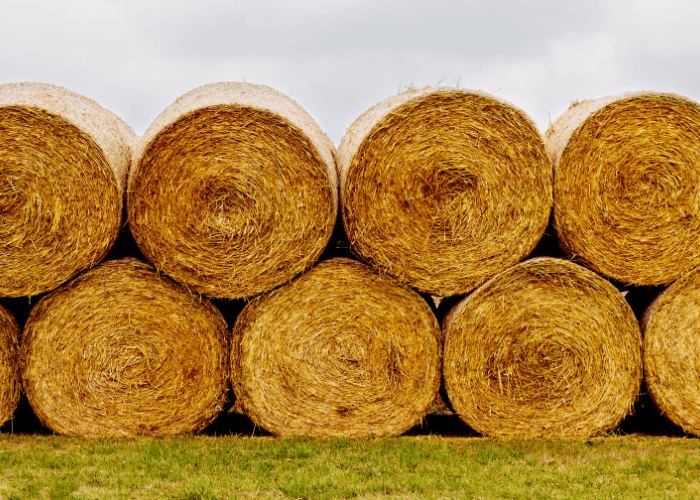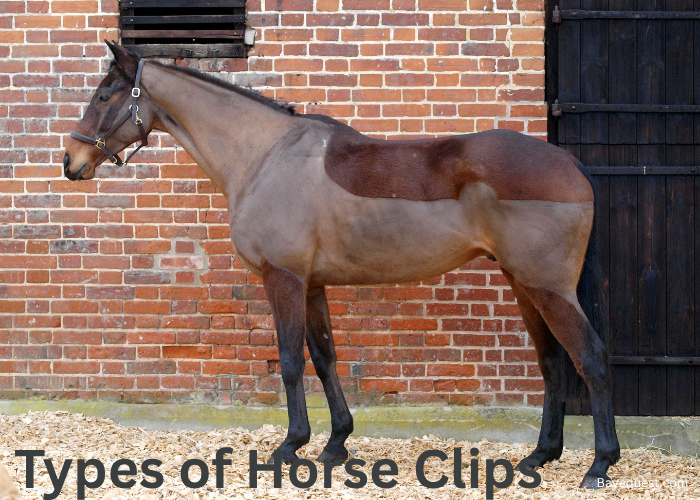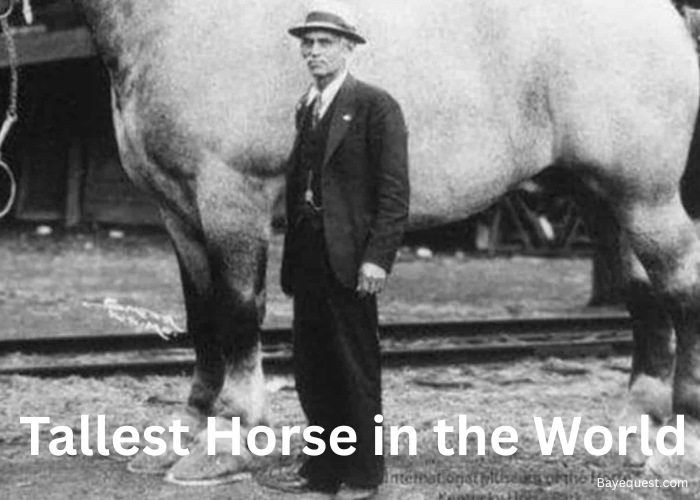Welcome to the world of hay. It’s not just about feeding animals; it’s about making smart choices.
Hay is a staple in the barn, but its cost can vary widely. Why is that? What makes one bale pricier than another? This blog “How much is a hay bale”, aims at answering all your questions.
From the type of hay to the time of year, many factors come into play. Understanding these elements can help you make informed decisions.
So, let’s dive in and discover the true value of a hay bale.
How Much is a Hay Bale?
The cost of one ton (2,000 pounds) of hay can vary significantly. Here are some general price ranges to give you an idea:
- Grass hay: Prices can range from $100 to $200 per ton.
- Alfalfa hay: Prices can range from $150 to $300 per ton or more, depending on quality.
- Mixed hay: Prices can vary, but they fall between the ranges for grass hay and alfalfa hay.
Hay Bale Sizes
Hay bales come in a variety of sizes, and each size affects the weight of a hay bale. Let’s break down the different hay bale sizes.
Round bales
These large cylindrical bales weigh between 500 and 2,000 pounds. They are commonly used for feeding large herds of cattle or horses and are usually stored outdoors.
Due to their size, moving and unrolling round bales require machinery like a tractor with a bale spear or a loader.
Large square bales
These big, rectangular bales weigh from 500 to 1,500 pounds and can be stacked neatly. They are preferred for their ease of handling and storage.
Large square bales are often used in commercial farming operations. They also require equipment for lifting and transport.
Small square bales
These are smaller and more manageable bales. They are rectangular in shape and weigh between 40 and 100 pounds.
They are also popular among small farm owners and horse enthusiasts because they can be handled without machinery.
Small square bales are easy to store and often used to feed smaller animals.
Hay bundle
This is a newer concept where several small square bales are bundled together into one large package using plastic or metal straps.
The weight of hay bundles can vary, but each small bale within the bundle weighs between 40 to 100 pounds. A common bundle might contain 21 small bales, so the total weight of the bundle would be around 840 to 2,100 pounds.
However, the exact weight can vary depending on the number of bales in the bundle and the weight of each individual bale.
Bagged hay
Hay can also be compressed and bagged for convenience. This format is used for specialty hays like alfalfa or for people who require smaller, more manageable quantities.
The weight of bagged hay can range from 40 to 60 pounds per bag. Bagged hay is easy to handle, store, and keep protected from the elements.
Cost of a Round Bale of Hay
When it comes to the cost of a round bale of hay, there’s no one-size-fits-all answer. The price can swing widely based on several factors.
First off, where you are matters. If you’re in a place where hay grows easily, you’ll probably pay less. But if you’re somewhere dry or cold, where growing hay is tough, expect to pay more.
Then there’s the type of hay. Alfalfa, known for its high nutrients, usually costs more than grass hay. So, what your animals need can change the price tag.
The time of year plays a role, too. In the summer, when hay is freshly cut, it might be cheaper. But in the winter, when hay is scarce, prices can shoot up.
And don’t forget about quality. Top-notch hay with the right mix of nutrients will cost more than hay that’s just so-so.
So, how much are we talking about? Well, prices can range from $75 to $90 or more for a round bale. It’s a big range, but it all comes down to those factors: location, type of hay, season, and quality.
Cost of a Square Bale of Hay
Just like with round bales, the price isn’t set in stone. It can change based on a few key things.
First, there’s the size of the bale. Smaller bales are usually cheaper than bigger ones. They’re easier to handle and move around, which is great if you don’t have a lot of space or big equipment.
Then, there’s the type of hay. Are you getting something like alfalfa, which is packed with nutrients? Or are you going for basic grass hay? Alfalfa tends to cost more, but it’s worth it if your animals need that extra boost.
Location is another big factor. If you’re close to where hay is grown, you’ll probably pay less. But if you’re far away, the cost of getting the hay to you can add up.
And, of course, there’s the quality of the hay. You want something that’s fresh and free of mold or weeds. Better quality usually means a higher price, but it’s important for keeping your animals healthy.
So, how much does a square bale of hay cost? It can be as low as $3 to $10 for a small bale or go up to $15 to $50 for a larger, higher-quality bale. The exact price depends on all those factors we talked about.
Cost of Bagged Hay
When it comes to bagged hay, the price is a bit different from traditional bales. Bagged hay is usually sold in smaller, more manageable quantities.
So, how much does it cost? Well, it depends on a few things. The type of hay is a big factor, and then there’s the quality.
Location plays a role, too. If you’re near where the hay is grown, you might get a better deal. But if it has to travel a long way to get to you, that’ll bump up the price.
Generally speaking, a bag of hay can cost anywhere from $5 to $20 or more. The exact price will depend on the factors we discussed.
Cost of Hay Bundle
The cost of a hay bundle can be tricky to pin down. That’s because a hay bundle is a group of smaller bales tied together.
It’s like buying in bulk, which can sometimes save you some cash. So, how much are we talking about? Well, it can vary a lot, but you might see prices ranging from $50 to $200 or more for a bundle.
Hay Cost, Size and Weight Summary
| Bale Type | Size | Dimensions (Approx.) | Weight | Cost (Approx.) |
|---|---|---|---|---|
| Round Bale | Large | 4-6 feet diameter | 500 – 2,000 pounds | $75 – $90+ per bale |
| Large Square Bale | Large | 3x3x8 feet or 4x4x8 feet | 500 – 1,500 pounds | $15 – $50+ per bale |
| Small Square Bale | Small | 2x2x4 feet | 40 – 100 pounds | $3 – $10+ per bale |
| Hay Bundle | Varies | Varies | 840 – 2,100 pounds | $50 – $200+ per bundle |
Factors that Impact the Cost of Hay Bales
Here are a few factors that can impact the cost of hay:
Location and transportation costs
Where you are can make a big difference in how much you pay for hay. If you’re near where hay is grown, you’re in luck. You’ll probably pay less. But if you’re far away, the cost of getting the hay to you can add up.
Transporting hay isn’t cheap, especially if it’s coming from a long distance.
Time of the year
Just like fruits and veggies, hay has its seasons. When hay is freshly cut and plentiful, like in the summer, prices might be lower.
But when it’s the middle of winter and hay is harder to come by, prices can go up. It’s all about supply and demand.
Quality of hay
Not all hay is created equal. Some hay is packed with nutrients and is super fresh, while other hay might be a bit dusty or not as rich.
Higher-quality hay costs more, but it’s often worth it for the health of your animals.
Market trends
Just like with anything else you buy, the hay market can go up and down. Things like changes in farming practices, fuel prices, or even the economy can impact how much you pay for hay.
Tips for Buying Hay
When buying hay, there are a few tips to keep in mind to make sure you’re getting the best deal and quality for your needs:
Assess quality. Before you buy, take a good look at the hay. You want it to be green, not too dry, and free from mold, dust, or weeds. Good quality hay is essential for the health of your animals, so don’t skip this step.
Compare prices. Don’t just go for the first price you see. Shop around a bit and check out different suppliers. Prices can vary, so it pays to do a little research. You might find a better deal just down the road.
Build relationships with suppliers. Once you find a good hay supplier, stick with them. Building a strong relationship can lead to better deals and more consistent quality. A reliable supplier can be a lifesaver when hay is hard to find.
Interesting read: What is the difference between hay and haylage?
How to Estimate Your Hay Expenses
Estimating your hay expenses involves a few key steps to ensure you’re budgeting accurately for your needs.
Here’s a simple guide to help you calculate how much hay you’ll need and how much it might cost:
1. Determine your animals’ hay needs
Start by determining how much hay each of your animals needs daily. For example, a horse might need about 20 pounds of hay daily.
Multiply the daily amount by the number of animals you have to get your total daily hay requirement.
2. Calculate your annual hay needs
Take your daily hay requirement and multiply it by the number of days you’ll be feeding hay. If you’re feeding hay year-round, that’s 365 days.
This will give you your total annual hay requirement in pounds.
3. Consider storage and waste
It’s important to factor in some extra hay for storage losses and waste. A general rule of thumb is to add about 10-15% extra to your total annual hay requirement to account for this.
4. Estimate the cost
Once you have your total annual hay requirement, you can start estimating the cost. Find out the current price of hay per ton or per bale in your area.
If you’re buying by the ton, convert your total annual requirement from pounds to tons (1 ton = 2,000 pounds).
Multiply your total annual hay requirement (in tons or bales) by the price per ton or per bale to get your estimated annual hay expense.
5. Plan for fluctuations
Remember that hay prices can fluctuate throughout the year. Budget a little extra to account for potential price increases.
Hay Types
The following are some of the types of hay available in our markets today:
Alfafa
Alfalfa hay is rich in protein, vitamins, and minerals, making it a popular choice for horses, dairy cows, and other livestock. It’s especially good for young, growing animals or those with high nutritional needs.
However, because it’s so nutrient-dense, it might not be the best choice for animals prone to weight gain or having certain health issues.
Oat hay
Oat hay is made from oat plants harvested before the grain fully matures. It’s a good source of fiber and is often used for horses and cattle.
Oat hay can be higher in sugar than other grass hays, so it must be fed cautiously to animals prone to metabolic disorders.
It’s also known for its palatability and is often used to encourage picky eaters.
Grasses
Orchard grass
Orchard grass hay is another type of grass hay similar to timothy but can be slightly higher in protein. It’s palatable and well-liked by many animals.
It’s a good all-around hay for various livestock, including horses, sheep, and goats.
Teff grass
Teff grass hay is a relatively new option in the hay market. It’s a warm-season annual grass that has gained popularity for its fine stem and high palatability.
It’s lower in protein compared to alfalfa but higher than many other grass hays. It’s also low in sugar, which can be beneficial for animals with metabolic issues.
Timothy grass
Timothy hay is grass hay that is lower in protein and calcium than alfalfa but still provides good nutrition. It’s often used for horses, rabbits, and guinea pigs.
It’s a good choice for adult animals that need a balanced diet without too many extra calories.
Bermuda grass
Bermuda grass hay is a fine-stemmed, leafy hay that’s lower in protein and often used for horses and cattle. It’s a good choice for animals that need a lower-protein diet.
It’s also known for being highly digestible and good for animals with sensitive stomachs.
Clover Hay
Clover hay is similar to alfalfa in terms of nutritional content, with high protein and energy levels. It’s often mixed with grass hays to balance the diet.
It’s suitable for dairy cows, sheep, and other livestock that need extra nutrients.
Straw
Straw is actually not a true hay but a byproduct of grain crops like wheat, barley, or oats. It’s the dry stalks left over after the grain has been harvested.
Straw is used more for bedding than for feeding because it’s low in nutritional value. However, it can be used as roughage or filler in the diets of animals with low energy needs.
How Long Will a Bale of Hay Last?
The duration a bale of hay will last depends on several factors, including the size of the bale, the type of animals being fed, and their individual needs.
Here’s a general guide to help you estimate how long a bale of hay might last:
1. Determine the size of the bale
Hay bales come in various sizes. For example, a small square bale might weigh around 40-60 pounds, while a large round bale can weigh between 500-1,500 pounds.
2. Know your animals’ daily hay intake
Different animals have different daily hay requirements. For instance, a horse might eat about 20-25 pounds of hay daily.
3. Calculate the duration
Divide the weight of the hay bale by the daily hay intake of your animal(s) to estimate how many days the bale will last.
For example, if you have a 60-pound small square bale and a horse that eats 20 pounds of hay per day: 60 lbs (bale weight) ÷ 20 lbs (daily intake) = 3 days
4. Adjust for multiple animals
If you’re feeding multiple animals, multiply the daily intake by the number of animals to get the total daily intake, and then divide the bale weight by this number.
5. Consider other factors
Remember that factors like weather conditions, the quality of the hay, and the animals’ activity levels can affect how much hay they consume. You might need to adjust your calculations based on these factors.
How Much Do Bales of Hay Cost? FAQs
How much is a bale of hay at Tractor Supply?
The price of a bale of hay at Tractor Supply can vary depending on factors such as the type of hay, the size of the bale, and the store’s location. Check the current prices on the Tractor Supply website or contact your local store for the most accurate information.
How much does 1 bale of hay cover?
The coverage area of one bale of hay depends on its size and the purpose for which it’s being used. For example, a small square bale of hay might cover approximately 50 to 60 square feet when used as mulch or bedding. For feeding purposes, the amount of hay needed would depend on the specific needs of the animals being fed.
How many bales of hay per acre can you produce?
The number of hay bales per acre depends on bale size and yield. One ton gives about 50 small square bales. Large square bales yield 2–2.5 per ton. Round bales give 1.5–2 per ton. If your field yields 4 tons, expect 6–200 bales depending on type.
How Much Do Hay Bales Cost? Conclusion
In the world of hay, prices are as varied as the types of hay themselves. From the lush alfalfa to the humble grass hay, each bale carries its own worth.
But it’s not just about the dollars and cents. It’s about understanding what your animals need and finding the right balance between quality and cost.
As you embark on your hay-buying journey, remember that the value of a bale lies not just in its price tag, but in the health and happiness it brings to your farm.








